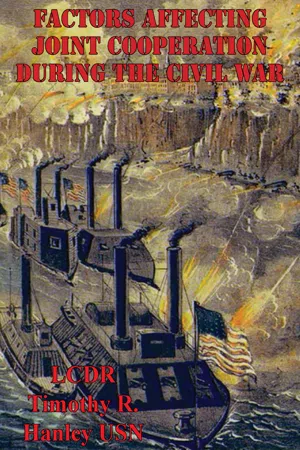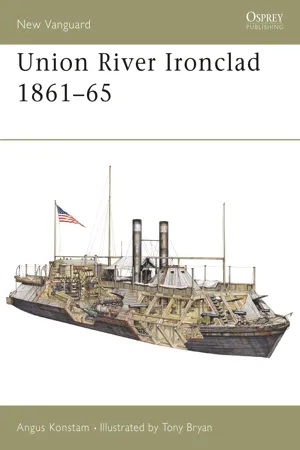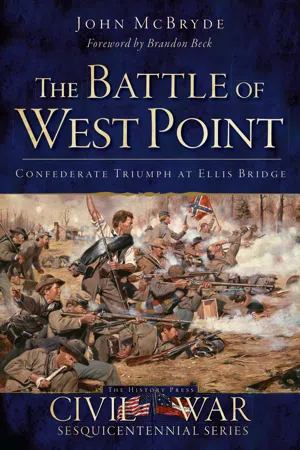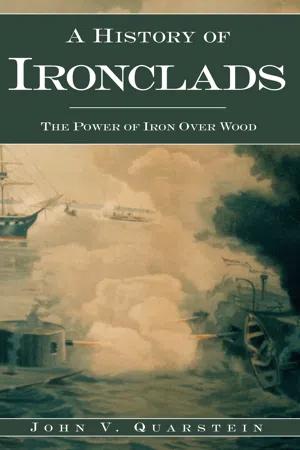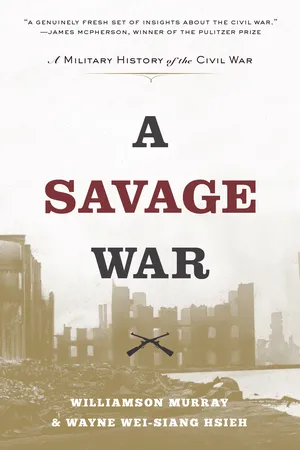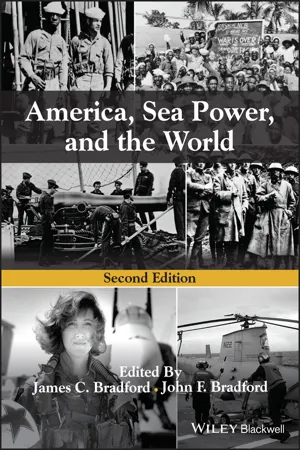History
Anaconda Plan
The Anaconda Plan was a Union strategy during the American Civil War to defeat the Confederacy by blockading southern ports and controlling the Mississippi River. The plan aimed to suffocate the South economically and prevent it from receiving supplies or exporting goods. It was named after the constricting snake, symbolizing the Union's intent to squeeze the Confederacy into submission.
Written by Perlego with AI-assistance
Related key terms
10 Key excerpts on "Anaconda Plan"
- LCDR Timothy R. Hanley USN(Author)
- 2015(Publication Date)
- Golden Springs Publishing(Publisher)
The strategic situation at the time of Sumter’s fall posed an enormous challenge for the Union. The Confederacy controlled virtually all the territory south of Missouri, Tennessee, and Maryland, and from Texas to Virginia. The only areas still under Federal control were at Fort Monroe, Virginia, and several small footholds on the coast of Florida at Key West and Fort Pickens. The modest industrial capacity of the South was, like its population, spread fairly evenly across its territory, making it difficult to identify any “strategic” points whose capture would hasten victory.The first strategy to earn serious consideration in the North was proposed by the general in chief, Gen. Winfield S. Scott. Scott’s plan consisted of two main points; using the Union’s control of the sea to blockade the Confederate coastline, and mounting a large joint expedition to seize the Mississippi River valley, dividing the eastern portion of the Confederacy from Texas and its long border with Mexico. The surrounding of the Confederacy and the strangulation of its war industries inherent in the blockade portion of the plan led to its becoming known as the “Anaconda Plan”.{48}Time would prove that the Anaconda Plan was militarily sound, indeed it was essentially the framework for the ultimate Union victory. Despite its military soundness the plan failed to recognize the political demands of the war. Propaganda, short 90-day enlistments, ignorance of the realities of war, and public expectations combined to place tremendous pressure on the Lincoln administration to fight and end the war quickly, very quickly. The proposed Mississippi expedition required a large body of trained troops, approximately 80,000, and could not possibly be organized before November, 1861, a politically unacceptable delay.{49}The War Department, under political pressure, abandoned the Anaconda Plan and prepared for an early, and hopefully decisive, march on the Confederate capitol at Richmond. Although discarded as a formal policy, the Anaconda Plan would continue to live on in the impetus it gave to the establishment of a blockade of the Confederate coast. On April 17th, 1861, a naval blockade was declared by the Federal Government along the coastline from South Carolina to Texas. Following the secession of Virginia and North Carolina on April 27th, the Federals extended the blockade to cover their coasts as well.{50}- eBook - ePub
- Angus Konstam, Tony Bryan(Authors)
- 2012(Publication Date)
- Osprey Publishing(Publisher)
DESIGN
BackgroundThe strategic need for a Union fleet on the Mississippi River and its tributaries has already been dealt with in this series (Osprey New Vanguard Series 49: Mississippi River Gunboats of the American Civil War 1861–65), so to avoid repetition we will only provide a brief summary of the situation. The “Anaconda Plan” devised by General Winfield Scott, President Abraham Lincoln, and Secretary of the Navy Gideon Welles was a strategy that envisioned the slow strangulation of the Confederacy, and the reduction of the ability of the secessionist states to wage war. It involved two main elements: the naval blockade of the Southern coastline, from the Potomac River to the Rio Grande, and the division of the Confederacy in two along the axis of the Mississippi River. The latter element called for a drive by land and naval forces southwards from Illinois and Missouri (supported by ancillary drives into Kentucky and Tennessee along the Cumberland and Tennessee Rivers), and a second assault from the Gulf of Mexico. This would involve the capture of New Orleans to seal off the river, then it would continue northwards to link up with the Union forces heading south. By wresting control of the Mississippi River from the South, the Union would split the Confederacy in two, and deny it access to the produce, resources and manpower of Texas and the trans-Mississippi regions.A Union seaman serving in the Western Gunboat Flotilla during the first years of the war. Although rarer on the Mississippi Theater than on the Atlantic coast, a number of black sailors served in the US Navy during the war. (Author’s collection)What the strategic plan failed to take into account was the lack of resources to carry out the task. Although the United States of America was a burgeoning industrial giant in 1861, and most of this industrial capacity was concentrated in the North, it would take time for this to begin producing the weapons of war needed to put the Anaconda Plan into effect. Also, as the North lacked naval shipyards or even a naval presence in these Western rivers, the Union would have to build a fleet from scratch, and would have to rely on civilian contractors to build its ships. More than anything else, this would influence the design of the Union ironclads which would soon appear on the Mississippi River and its tributaries, and it would lead to the creation of a type of ship which was exclusively suited to the riverine environment of the Western rivers. - eBook - ePub
The Campaigns for Vicksburg 1862-63
Leadership Lessons
- Kevin Dougherty(Author)
- 2011(Publication Date)
- Casemate(Publisher)
Scott’s approach was to avoid a bloody war by mobilizing an army so big and powerful that the Confederacy would negotiate a return to the Union without a fight. In the meantime, he envisioned seizing the entire line of the Mississippi and Ohio Rivers in order to split the Confederate states east of the Mississippi from those in the west. At the same time, he would impose a naval blockade of the Confederate coast. The plan became known as the “Anaconda Plan,” because, like the big snake, it would squeeze the Confederacy into submission.Passage contains an image
The Anaconda Plan: Scott’s great snake. Courtesy of the Library of Congress
Passage contains an image
Part of Scott’s plan for gaining control of the Mississippi involved a decisive battle at New Orleans. He told President Lincoln the Federals must “fight a battle at New Orleans and win it, and thus end the war.” On April 25, 1862, Scott’s desire was accomplished when Admiral David Farragut conducted a daring run past the two forts that were supposed to safeguard New Orleans and captured the city.New Orleans was indeed a great achievement for the Union, placing one of the South’s premier cities and the mouth of the Mississippi under Federal control. Still, New Orleans was a limited victory in that the strategic momentum was soon lost. The problem was that the Federals did not have a detailed plan in place for what to do next.As Farragut pondered this situation, one obvious target was the Confederate bastion at Vicksburg, about 400 miles above the Crescent City. Using a plan similar to what had worked for him at New Orleans, Farragut attempted to subdue the city in May, but this time his bombardment was unsuccessful. Then, fearing the receding waters of the Mississippi might strand his oceangoing warships in the summer months, Farragut reluctantly decided to withdraw. He left six gunboats below Vicksburg and returned to New Orleans. Historian Rowena Reed laments Farragut’s delay and halfhearted attempt at Vicksburg writing, “Had the Federal expedition moved upriver in force immediately after the fall of New Orleans, without allowing the enemy time to recover from the initial confusion of defeat, the entire Mississippi would have been in Union control by the summer of 1862.” - John McBryde(Author)
- 2013(Publication Date)
- The History Press(Publisher)
Part IPREPARATIONS FOR A RAIDThe best strategy is always to be very strong first in general, and then at the decisive point…There is no higher and simple law of strategy than that of keeping one’s forces concentrated.–Sun TzuEarly in the war, General Winfield Scott, commander of all Union forces, devised a plan to choke the South into submission. His plan became known as the Anaconda Plan because it resembled a South American snake, stretching from the southern ports in the Atlantic and wrapping around Florida and into the Gulf of Mexico. The anaconda then wrapped itself around Mississippi up the Mississippi River. By January 1864, this plan had been accomplished. No supplies were entering the South from overseas ports except by blockade runners. Both the Confederate army and the citizens of the South suffered from the Union blockade.FEDERAL DIVISION OF THE SOUTHBy January 1864, General Grant desired to further subdivide the South in the Western Theater by sending William T. Sherman on a mission to scorch a swath of land across the southern half of Mississippi and maybe even Alabama. The plans included Sherman occupying Selma and Mobile, Alabama. The east bank of the Mississippi needed to be cleared of Confederate snipers shooting at Union gunboats and supply boats moving up and down the Mississippi River. Basically, Grant wanted to clear Mississippi of all Confederate opposition. He wanted to take or destroy all Confederate stores supplying the Confederate army. The task fell to Sherman, who at the time was in Knoxville after the Battle of Chattanooga. Sherman was in command of the Department of the Tennessee, “which embraced substantially the territory on the east bank of the Mississippi River, from Natchez up to the Ohio River, and thence along the Tennessee River as high as Decatur and Bellefonte, Alabama.”14 General McPherson was at Vicksburg, and General Hurlbut was at Memphis. They both provided Sherman regular reports concerning Confederates in each of their areas. In his memoirs, Sherman said that there was “a considerable force of infantry and cavalry in the State of Mississippi, threatening the river, whose navigation had become to us so delicate and important matter.”15- eBook - ePub
A History of Ironclads
The Power of Iron Over Wood
- John V. Quarstein(Author)
- 2007(Publication Date)
- The History Press(Publisher)
Few facets of the Civil War more closely reinforce the technology and attrition theme than does the war on the water. The war witnessed an overnight change to naval tactics. Boarding tactics and “fighting instructions” became archaic and forgotten due to steam power, ironclads, revolving turrets, torpedoes and rifled cannons. These tools left an incredible mark on future ship and ordnance design.Secretary of the Navy Gideon Welles was able to create naval policy that followed the concepts of Lieutenant General Winfield Scott’s Anaconda Plan. It was an effective blueprint for victory. The Union navy enacted the Anaconda Plan through its decisive blockade and capture of Southern ports. Federal fleet actions resulted in the Union control of the Mississippi, which divided the Confederacy while simultaneously closing each outlet to European goods. The fall of Fort Fisher proved the Union navy’s effectiveness; as Colonel William Lamb recounted, “For the first time in the history of sieges the land defenses of the works were destroyed, not by any act of the besieging army, but by the concentrated fire, direct and enfilading, of an immense fleet plowed into them without intermission, until…the slopes of the works were rendered practicable for assault.”The Federals had brought the largest fleet assembled in American waters. Union ironclads and wooden steam-powered frigates provided the mobility to direct superior firepower at any and every defensive point. Fort Fisher was overwhelmed and the fort’s capture basically marked the end of Confederate resistance. General R.E. Lee recognized that without the flow of supplies entering Wilmington, Richmond could not be held. The Union navy proved its critical role in the economic, financial and psychological defeat of the Confederacy.“USS Carondelet & CSS Arkansas ,” engraving, ca. 1863. Courtesy of John Moran Quarstein .The Confederacy entered the war with significant naval disadvantages. The long coastline and vast tracks of territory traversed by navigable streams provided the U.S. Navy with numerous opportunities to disrupt Confederate commerce and military operations. Since the South had no navy at the war’s beginning, the task to counter the Federals’ overwhelming advantages fell onto the shoulders of Confederate Secretary of the Navy Stephen Russell Mallory. Mallory initially misjudged the capability of Southern ironclads to break the Union blockade and threaten Union cities as well as the ability of coastal forts to defend against Federal naval assault. Steam power and rifled guns proved at Port Royal Sound, New Orleans, and the North Carolina Sounds that some comprehensive system of defense in depth was needed. Flag Officer J.K. Mitchell noted that “the enemy, with his large naval establishment and unlimited transportation, has, in all his expeditions against us, appeared in such overwhelming force as to render successful resistance on the part of ours utterly out of the question.” - eBook - ePub
A Savage War
A Military History of the Civil War
- Williamson Murray, Wayne Wei-Siang Hsieh(Authors)
- 2018(Publication Date)
- Princeton University Press(Publisher)
CHAPTER 5 Stillborn between Earth and Water: The Unfulfilled Promise of Joint Operations Wilson, I am a damned sight smarter man than Grant; I know a great deal more about war, military history, strategy, and grand tactics than he does; I know more about organization, supply, and administration and about everything else than he does; but I’ll tell you where he beats me and where he beats the world. He don’t care a damn for what the enemy does out of his sight, but it scares me like hell! —William T. Sherman (Wilson, Under the Old Flag) It would take until the winter of 1863/64 for Grant to formulate a victorious Federal military strategy of overwhelming and coordinated military pressure across the whole breadth of the Confederacy’s land and sea frontiers, and a full year’s worth of campaigning between 1864 and 1865 to execute that strategy. Nevertheless, one should not believe that the Federal cause saw a complete absence of strategic planning at the outset of the war. In what the Northern press later dubbed the Anaconda Plan, Scott had proposed a Union military strategy early in the war combining a naval blockade with a waterborne expedition down the Mississippi “to clear out and keep open this great line of communication in connection with the strict blockade of the seaboard, so as to envelop the insurgent States and bring them to terms with less bloodshed than by any other plan.” 1 Union naval power would also seize New Orleans at the Mississippi’s mouth, while riverine transport would allow the proposed expeditionary force to turn Confederate positions - eBook - ePub
- James C. Bradford, John F. Bradford, John F. Bradford, James C. Bradford(Authors)
- 2022(Publication Date)
- Wiley-Blackwell(Publisher)
CHAPTER 8 The Civil War on Rivers and Coastal WatersWayne HsiehMilitary historians of the American Civil War have seen the sectional conflict as a war fought primary on dry land, with naval power playing only a subordinate role in the Union's military efforts. Nevertheless, subordinate need not mean insignificant, and naval power played an important and necessary part in securing Union victory. Indeed, General‐in‐Chief Winfield Scott, the Union's most seasoned commander of land forces, incorporated naval power into his early strategic planning for Union victory. In a proposal later dubbed the “Anaconda Plan” by contemporary observers, Scott suggested that, in addition to a naval blockade of the Confederate coast, a powerful Union military expedition should advance down the Mississippi River, “the object being to clear out and keep open this great line of communication in connection with the strict blockade of the seaboard, so as to envelop the insurgent States and bring them to terms with less bloodshed than by any other plan.”1 Scott unsurprisingly proved prescient in his expectation that such an expedition would require both gunboats and steamers acting as troop transports moving downstream, even as Union forces assaulted and then occupied New Orleans near the Mississippi's mouth.The importance of close cooperation between ground and naval forces holds obvious relevance for Scott's planned expedition down the Mississippi, but enforcement of the blockade also required well‐coordinated joint operations. Not only did the Union blockading squadrons require bases on the southern coastline to refuel and refit their vessels, but also the vast expanse of the Confederacy's 3500 miles of coastline with its 189 harbors and coves made it impossible to maintain a truly leak‐proof blockade without capturing Confederate port cities. Even as the Union Navy rapidly expanded and acquired vital bases on the Confederate coast to supply and maintain its blockading squadrons, specialized Confederate blockade runners could take advantage of the cover of darkness, stealth, and speed to evade Union patrols. The capture and subsequent closure, however, of Confederate ports provided a solution to the insuperable logistical and technological problems of maintaining an offshore blockade. But the capture of Confederate port cities usually required joint cooperation between ground and naval sources – cooperation that was not necessarily forthcoming due to interservice rivalries between the Union Army and Navy. Such rivalries, combined with and exacerbated by the inattention of senior Union military and naval leaders, resulted in missed Union opportunities to close Confederate ports during the war's early years. In short, Scott's mooted plans for a riverine expedition down the Mississippi and for a naval blockade of the Confederacy's ports required military and - eBook - ePub
- O. Edward Cunningham, Gary D. Joiner, Timothy B. Smith, Gary D. Joiner, Timothy B. Smith(Authors)
- 2009(Publication Date)
- Savas Beatie(Publisher)
Chapter 2
Lincoln Takes a Hand
NO ONE KNOWS FOR certain who first conceived of the idea of a great Union push down the lines of the Mississippi and Tennessee rivers. Perhaps many men thought of the plan in its broadest outlines at the same time. It was certainly evident to anyone who looked at a map that such an offensive utilizing the rivers as avenues of transportation and invasion would be the easiest way to conquer this region in the South, by splitting the Confederacy in two.In April 1861, while yet an officer of the Ohio militia, young George McClellan proposed to General Winfield Scott, the fat and aging General-in-Chief of the United States Army, that one possible plan of action would be to “cross the Ohio at Cincinnati or Louisville with 80,000 men, march straight on Nashville, and act according to circumstances,” with the ultimate aim of advancing on “Pensacola, Mobile and New Orleans.”1 Just days later, Scott presented his own famous Anaconda Plan. This proposed a “complete blockade of the Atlantic and Gulf ports … in connection with such blockades,” proposing a mighty “movement down the Mississippi to the ocean, with a cordon of posts at proper points… the object being to clear out and keep open this great line of communication in connection with the strict blockade of the seaboard, so as to envelop the insurgent states,” and crush them with the minimum amount of blood shed. Scott went on to say in a letter to McClellan that twelve to twenty steam gunboats would be needed, besides transports to carry 60,000 men who would be inducted in the army.2 Scott’s plan did not allow for the difficulties that would be set forward in an invasion, and he underestimated the forces needed, but at least he offered a beginning for Union strategy in the West.Nor were the Southerners unaware of the strategic possibilities inherent in the situation. Work continued on developing fortifications to protect the Mississippi, Cumberland, and Tennessee, while the Confederates were making all efforts possible to mass troops and equipment in the West. A young Southern ordnance officer, Captain W. R. Hunt, in a letter containing recommendations to Major General Polk, written on August 12, pointed out succinctly that “if the war should unfortunately be prolonged, the Valley of the Mississippi must ultimately become its great theater, for the enemy now working to subjugate the South knows the value of our great artery of commerce and of the prominent cities upon it too well for us to doubt that he will bend all his energies to control them.”3 Captain Hunt’s fears were well founded, for just a few hundred miles north, various Union officers were already beginning to mull over ideas for a drive down the river line. One of the first high ranking officers to bring up the matter was Colonel Charles Whittlesey, a graduate of West Point in 1831 and the chief of Brigadier General Ormsby M. Mitchel’s engineers. In a dispatch dated November 20, Whittlesey wrote General Halleck suggesting the propriety “of a great movement by land and water up the Cumberland and Tennessee Rivers.”4 His idea was that this would al low the army to operate along the water lines half way to Nashville without endangering the supply line, which would be vulnerable to attack by cavalry if operating overland along the crude road system. This would also make possible, even probable, the Confederate evacuation of Columbus, since it would have the effect of threatening their railway communications. Further, it was in Colonel Whittlesey’s opinion the most passable route into Tennessee.5 - eBook - ePub
Connecticut in the American Civil War
Slavery, Sacrifice, and Survival
- Matthew Warshauer(Author)
- 2014(Publication Date)
- Wesleyan University Press(Publisher)
While Connecticut troops were baptized by fire, those back in New England were tasked with the continued necessity of maintaining a strong home front. This required a virtual river of supplies, maintained by both soldiers’ aid societies and individual families. There was also the importance of holding down the Democrat peace movement and maintaining Republican political control. With the governor’s term of office lasting only one year, Governor Buckingham and Republicans had to do battle each spring lest they lose the political war at home. In this sense, the military and political engagements had a symbiotic relationship. The ebb and flow of Union success naturally influenced voters’ confidence in the state’s administration, and the health of the government at home and its ability to keep “traitors” in check had a resounding effect on the confidence of soldiers in the field. It was a delicate balance that was often made more difficult by the actions of the federal government and the Union military.When President Lincoln announced his preliminary Emancipation Proclamation in September 1862, Democrats renewed their onslaught against the war. They had charged from the outset that abolition and what they called “negro philanthropy” were the true Republican goals. Lincoln’s proclamation opened the door for more such Democratic assaults, even though he and other Republicans argued that emancipation was a means of winning the war, not an end in itself. Nonetheless, the very idea of emancipation created a tempest, and, combined with the shocking bloodletting at battles like Antietam and Fredericksburg, the Union was at a low ebb by the end of the year.The Anaconda Plan required control of a vast coastline dotted with inlets, bays, creeks, swamps, and bayous, any one of which could allow blockade runners to slip away from Union pursuit or gain access to the South. And, of course, the region was the Confederates’ backyard, and they knew, far better than any Yankee, how to navigate the watery morass. Nonetheless, in late 1861, the Union Navy sailed south to shut down rebel trade. The first engagements involved the taking of Pamlico Sound as well as Fort Walker and Fort Beauregard. - Major Alan J. Deogracias II(Author)
- 2014(Publication Date)
- Golden Springs Publishing(Publisher)
CHAPTER 3 — IMPACT ON THE UNITED STATES NAVY, 1862-1871
When Abraham Lincoln established the blockade of Southern ports on 19 April 1861, known as the Anaconda Plan, the United States Navy found itself woefully unprepared for the task at hand. The mission was quite overwhelming; the southern coastline was over 3,000 miles long, not including the Mississippi River and her tributaries. The Navy was not organized or equipped for such a daunting task. The U.S. Navy’s primary mission at the time was to protect United States merchant shipping overseas and defeating enemy ships in one on one combat. “In the naval context, when the Confederate forces fired on Fort Sumter the Navy was still cruising on station and preparing for a repeat of the War of 1812.”{44}After the blockade of the Confederacy was established, the Navy reorganized and formed four blockading squadrons in early 1862: the North Atlantic, South Atlantic, East Gulf, West Gulf, and Mississippi Squadrons. Hampton Roads was in the area of operations of the North Atlantic Blockading Squadron. In addition to the four blockading squadrons the Mississippi River flotilla was transferred to the Navy from the army in 1862.{45} After the battle of Hampton Roads it would go through more radical change to adapt to a new form of naval warfare.Four distinct themes resulted from the Battle of Hampton Roads that changed the United States Navy. First, the Virginia proved that a wooden ship was no match for an ironclad. Second, the Monitor proved the best way to stop an ironclad was with another ironclad. Third, the Monitor and Virginia were not designed as sailing ships and fought with steam as the only source of propulsion. Finally, the Monitor’s turret allowed the ship to fire in any direction and protected the crew from enemy fire. The United States was gripped with “Monitor Fever” after the news reports of the successful first battle of ironclads at Hampton Roads and an ironclad program to produce more monitors was born.{46}
Index pages curate the most relevant extracts from our library of academic textbooks. They’ve been created using an in-house natural language model (NLM), each adding context and meaning to key research topics.
